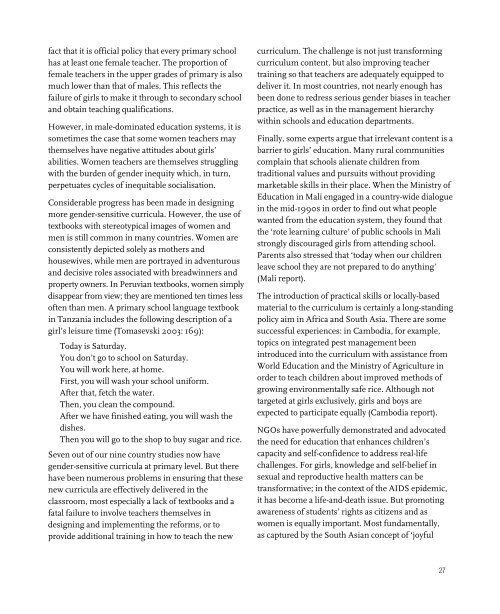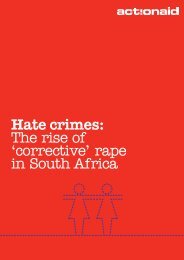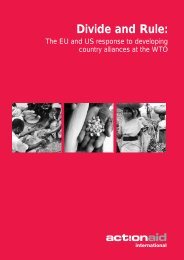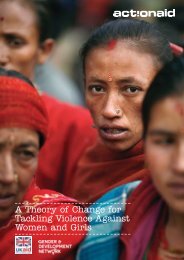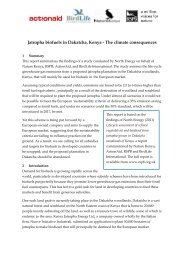A fair chance - United Nations Girls' Education Initiative
A fair chance - United Nations Girls' Education Initiative
A fair chance - United Nations Girls' Education Initiative
You also want an ePaper? Increase the reach of your titles
YUMPU automatically turns print PDFs into web optimized ePapers that Google loves.
fact that it is official policy that every primary schoolhas at least one female teacher. The proportion offemale teachers in the upper grades of primary is alsomuch lower than that of males. This reflects thefailure of girls to make it through to secondary schooland obtain teaching qualifications.However, in male-dominated education systems, it issometimes the case that some women teachers maythemselves have negative attitudes about girls’abilities. Women teachers are themselves strugglingwith the burden of gender inequity which, in turn,perpetuates cycles of inequitable socialisation.Considerable progress has been made in designingmore gender-sensitive curricula. However, the use oftextbooks with stereotypical images of women andmen is still common in many countries. Women areconsistently depicted solely as mothers andhousewives, while men are portrayed in adventurousand decisive roles associated with breadwinners andproperty owners. In Peruvian textbooks, women simplydisappear from view; they are mentioned ten times lessoften than men. A primary school language textbookin Tanzania includes the following description of agirl’s leisure time (Tomasevski 2003: 169):Today is Saturday.You don’t go to school on Saturday.You will work here, at home.First, you will wash your school uniform.After that, fetch the water.Then, you clean the compound.After we have finished eating, you will wash thedishes.Then you will go to the shop to buy sugar and rice.Seven out of our nine country studies now havegender-sensitive curricula at primary level. But therehave been numerous problems in ensuring that thesenew curricula are effectively delivered in theclassroom, most especially a lack of textbooks and afatal failure to involve teachers themselves indesigning and implementing the reforms, or toprovide additional training in how to teach the newcurriculum. The challenge is not just transformingcurriculum content, but also improving teachertraining so that teachers are adequately equipped todeliver it. In most countries, not nearly enough hasbeen done to redress serious gender biases in teacherpractice, as well as in the management hierarchywithin schools and education departments.Finally, some experts argue that irrelevant content is abarrier to girls’ education. Many rural communitiescomplain that schools alienate children fromtraditional values and pursuits without providingmarketable skills in their place. When the Ministry of<strong>Education</strong> in Mali engaged in a country-wide dialoguein the mid-1990s in order to find out what peoplewanted from the education system, they found thatthe ‘rote learning culture’ of public schools in Malistrongly discouraged girls from attending school.Parents also stressed that ‘today when our childrenleave school they are not prepared to do anything’(Mali report).The introduction of practical skills or locally-basedmaterial to the curriculum is certainly a long-standingpolicy aim in Africa and South Asia. There are somesuccessful experiences: in Cambodia, for example,topics on integrated pest management beenintroduced into the curriculum with assistance fromWorld <strong>Education</strong> and the Ministry of Agriculture inorder to teach children about improved methods ofgrowing environmentally safe rice. Although nottargeted at girls exclusively, girls and boys areexpected to participate equally (Cambodia report).NGOs have powerfully demonstrated and advocatedthe need for education that enhances children’scapacity and self-confidence to address real-lifechallenges. For girls, knowledge and self-belief insexual and reproductive health matters can betransformative; in the context of the AIDS epidemic,it has become a life-and-death issue. But promotingawareness of students’ rights as citizens and aswomen is equally important. Most fundamentally,as captured by the South Asian concept of ‘joyful27


